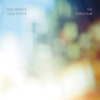 This latest collaboration between Nurse With Wound’s Colin Potter and guitarist/Twenty Herz label-head Paul Bradley is an experiment in returning to an earlier, less complicated way of making an album: only two guys in a studio with some instruments. Despite that, it is not a stunning or radical departure from either musician’s past solo work, though it bears a stronger resemblance to ambient’s early days than usual. It was an inspired move in theory, but the end result suggests that making music the complicated way might be a still better idea.
This latest collaboration between Nurse With Wound’s Colin Potter and guitarist/Twenty Herz label-head Paul Bradley is an experiment in returning to an earlier, less complicated way of making an album: only two guys in a studio with some instruments. Despite that, it is not a stunning or radical departure from either musician’s past solo work, though it bears a stronger resemblance to ambient’s early days than usual. It was an inspired move in theory, but the end result suggests that making music the complicated way might be a still better idea.
The premise of The Simple Plan is an appropriately simple one: record an album in real-time using real instruments with virtually no aid from computers or digital processing techniques. For this purpose, Bradley and Potter employed an array of analog synthesizers, guitars, and effects pedals. The challenge of this endeavor was further enhanced by the fact that Paul Bradley had never played a synthesizer “live” before. He seems to have managed just fine, however.
The album opens with the delicate, shimmering swells of “Embrace,” a piece very much in the vein of Eno’s pastoral early ambient works. It is “ambient” in the truest sense of the term, as it is very easy to forget that it is even playing due to its slow-moving subtlety and consonance. Nevertheless, I found it to be quite a beautiful piece once I gave it my full attention. While overtly it is simply a slowly drifting cloud of sound, there is quite a bit of action taking place in a small-scale way: the timbres and volumes of tones shift, disquieting passing tones wander in and out, and the notes smear and bleed together to yield slight dissonances and oscillations.
As it turns out, ”Embrace” is a bit of an aberration. It is by far the most placid and nuanced piece on the album, as the remaining four songs tweak its template with an increased focus on low-end and density. Also, while “Embrace” contentedly floats along for the entirety of its 18-minute duration, the remainder of the tracks merely use that as a starting point before snowballing into something more hefty. The differences between the songs are not huge, but they effectively serve to differentiate them. The title track, for example, leans much more heavily on a central droning tone and gradually escalates in power while maintaining a faint swaying pulse. Also, it ends with the unexpectedly melodic bloops and bleeps of a static-washed coda. The longest piece on the album, “Gloaming,” places even more emphasis on rhythm, coalescing into a heavy throb while Bradley’s guitar loops glisten above it. It is also one of the most intense pieces on the album, as the loops gradually mass to form a thickly layered and somewhat distorted middle section. The piece that follows it, “Alta Mesa,” achieves a similar display of power by gradually swelling to an engulfing roar.
The intended purpose of this project was to “create a simpler, more organic piece of work.” In those regards, it is a mixed success. While certainly restrained, the ebbing and flowing interplay between notes in “Embrace” sounds vibrant and alive. However, the actual sounds are still very artificial: the guitars rarely sound like guitars and very few sounds are less organic than analog synthesizers. Also, while the recording process itself was simple, the music is actually quite a bit busier and less spacious and intimate than much of Paul Bradley's solo work. When the process is taken out of the equation, what is left is merely a decent, albeit somewhat regressive, ambient album. Several other artists could have made an album like this: Bradley and Potter’s plan, while admirable, was either too simple or not simple enough to betray much personality or uniqueness.
(Note- the currently sold-out limited edition of this album came with a bonus disc (Accreation) of reworked versions of the songs made without any limitations at all. It is significantly better than The Simple Plan, which makes its unavailability perplexing.)
Samples:
Read More

